常用动词的现在分词和第三人称单数汇总表
- 格式:docx
- 大小:19.33 KB
- 文档页数:3
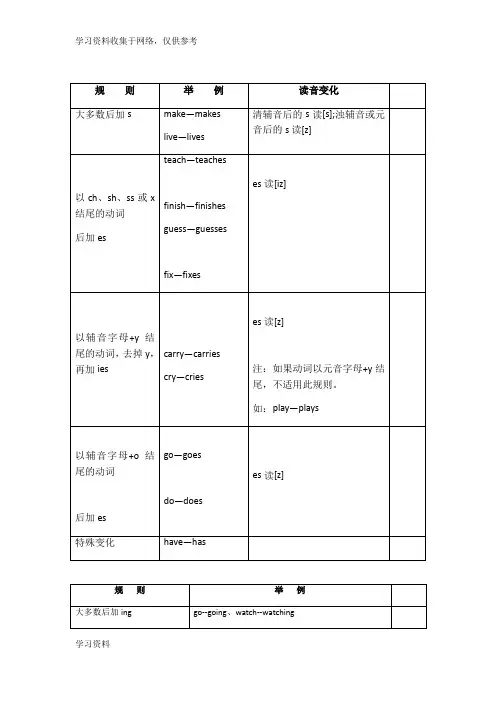
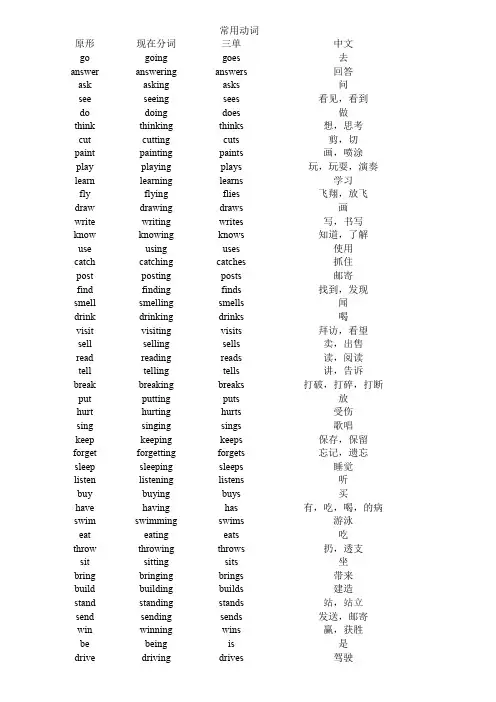
常用动词原形现在分词三单中文go going goes 去answer answering answers 回答ask asking asks 问see seeing sees 看见,看到do doing does 做think thinking thinks 想,思考cut cutting cuts 剪,切paint painting paints 画,喷涂play playing plays 玩,玩耍,演奏learn learning learns 学习fly flying flies 飞翔,放飞draw drawing draws 画write writing writes 写,书写know knowing knows 知道,了解use using uses 使用catch catching catches 抓住post posting posts 邮寄find finding finds 找到,发现smell smelling smells 闻drink drinking drinks 喝visit visiting visits 拜访,看望sell selling sells 卖,出售read reading reads 读,阅读tell telling tells 讲,告诉break breaking breaks 打破,打碎,打断put putting puts 放hurt hurting hurts 受伤sing singing sings 歌唱keep keeping keeps 保存,保留forget forgetting forgets 忘记,遗忘sleep sleeping sleeps 睡觉listen listening listens 听buy buying buys 买have having has 有,吃,喝,的病swim swimming swims 游泳eat eating eats 吃throw throwing throws 扔,透支sit sitting sits 坐bring bringing brings 带来build building builds 建造stand standing stands 站,站立send sending sends 发送,邮寄win winning wins 赢,获胜be being is 是drive driving drives 驾驶※附一:动词三单★一般现在时:表示经常性的事情。
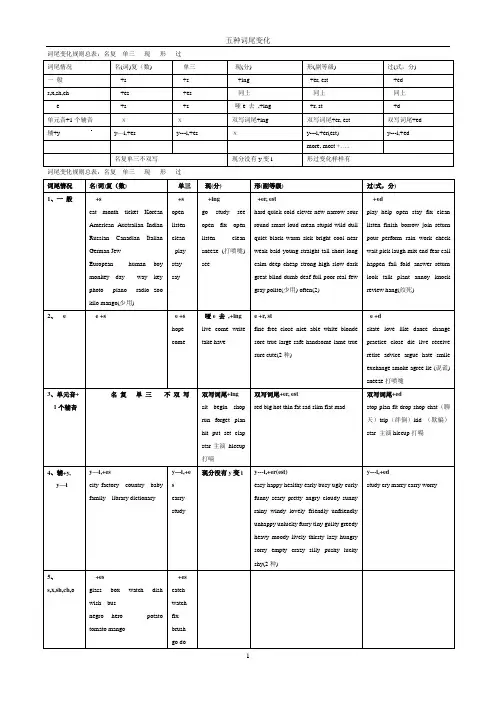
词尾变化规则总表:名复单三现形过词尾情况名(词)复(数) 单三现(分) 形(副等级) 过(式,分) 一般+s +s +ing +er, est +eds,x,sh,ch +es +es 同上同上同上e +s +s 哑e 去,+ing +r, st +d单元音+1个辅音ⅹⅹ双写词尾+ing 双写词尾+er, est 双写词尾+ed 辅+y y—i,+es y---i,+es ⅹy---i,+er(est) y---i,+edmore, most +…..名复单三不双写现分没有y变i 形过变化样样有词尾变化规则总表:名复单三现形过词尾情况名(词)复(数) 单三现(分) 形(副等级) 过(式,分)1、一般+scat month ticket KoreanAmerican Australian IndianRussian Canadian ItalianGerman JewEuropean human boymonkey day way keyphoto piano radio zookilo mango(少用)+sopenlistencleanplaystaysay+inggo study seeopen fix openlisten cleansneeze (打喷嚏)see+er, esthard quick cold clever new narrow sourround smart loud mean stupid wild dullquiet black warm sick bright cool nearweak bald young straight tall short longcalm deep cheap strong high slow darkgreat blind dumb deaf full poor real fewgray polite(少用) often(2)+edplay help open stay fix cleanlisten finish borrow join returnpour perform rain work checkwait pick laugh mix end fear callhappen fail fold answer returnlook talk plant annoy knockreview hang(绞死)2、 e e +s e +shopecome哑e 去,+inglive come writetake havee +r, stfine free close nice able white blondesore true large safe handsome lame truesure cute(2种)e +dskate love like dance changepractice close die live receiveretire advice argue hate smileexchange smoke agree lie (说谎)sneeze打喷嚏3、单元音+ 1个辅音名复单三不双写双写词尾+ingsit begin shoprun forget planhit put set clapstar主演hiccup打嗝双写词尾+er, estred big hot thin fat sad slim flat mad双写词尾+edstop plan fit drop shop chat(聊天)trip(绊倒)kid (欺骗)star 主演hiccup打嗝4、辅+y,y—i y—i,+escity factory country babyfamily library dictionaryy---i,+escarrystudy现分没有y变i y---i,+er(est)easy happy healthy early busy ugly curlyfunny scary pretty angry cloudy sunnyrainy windy lovely friendly unfriendlyunhappy unlucky furry tiny guilty greedyheavy moody lively thirsty lazy hungrysorry empty crazy silly pushy luckyshy(2种)y---i,+edstudy cry marry carry worry5、s,x,sh,ch,o+esglass box watch dishwish busnegro hero potatotomato mango+escatchwatchfixbrushgo do名词变复数不规则变化f,fe---v+es thief—thieves (小偷)self—selves(自己)leaf—leaves(叶子) life---lives (命)half---halves;(一半)wife---wives (妻子)shelf—shelves(架)knife---knives(刀)wolf—wolves(狼)roof—roofs(屋顶)chef—chefs(厨师) scarf—scarfs,scarves( 围巾) 词形不变Chinese Japanese sheep deer Swiss 中日羊鹿瑞士人变成e man---men Englishman---Englishmen Frenchman---Frenchmen foot---feet tooth---teeth只有复数clothes pants trousers shorts scissors (剪刀)compasses (圆规) glasses(眼镜)形复实单news maths politics physics形单实复cattle people police 谓语用复数特殊变化child---children mouse--mice合成名词只变一词boy student---boy students night school---night schools pencil sharpener-- sharpeners 两词都变woman doctor---women doctors man singer---men singers动词的现在分词形式不规则变化词尾情况规则例词ie ie----y,+ing die tie lie 形容词、副词的比较级、最高级形式不规则变化不规则变化多数多音节词more,most+原级useful famous quickly beautiful creative serious outgoing amazing awful exciting excited interested famous intelligentexpensive inexpensive tired honest wonderful interesting fantastic sadly beautifully delicious slowly open difficult carefullybeautifully deeply careless active athletic original foolish wrong right casual casually nervous unusual usual modest naturalpleased realistic popular loving inexpensive comfortable convenient crowded truly exhausted embarrassed convincing carelesscareful carefully enormous completely particularly quickly quietly aggressive specifically disappointed disgusted successfulsuitable educational gradually unpleasant pleasant polite(2种) common(2种)原级比较级最高级词义good/well better bestbad/ill worse worstmany/much more mostlittle less leastfar farther farthest 距离further furthest 程度late later latest 时间latter last 顺序old older oldest 年龄关系elder eldest 兄弟姐妹关系GO FOR IT PT PPmeaning root form pt pp meaning root form pt pp让允许let let let 喂feed fed fed阅读read read read 遇见meet met met放置put put put 感觉feel felt felt花费cost cost cost 嗅,发出smell smelt smelt打hit hit hit 拼写spell spelt spelt砍切割cut cut cut 损坏,宠坏spoil spoilt spoilt伤害弄伤hurt hurt hurt 发现,找到 find found found撒抛投cast cast cast 举着,握着hold held held关闭 shut shut shut 听见hear heard heard沉入安置set set set 有,吃have/has had had传播展开spread spread spread 丢失,失去lose lost lost使阴暗overcast overcast overcast 离开,留下leave left left广播broadcast broadcast broadcast 制造,使得make made made预测forecast forecast forecast 射击射伤shoot shot shot爆炸burst burst burst 照耀发光shine shone shone捕捉赶上catch caught caught 坐sit sat sat教书教学teach taught taught 临时照顾babysit babysat babysat 想认为think thought thought 吐,吐唾液spit spat spat买buy bought bought 打赢,获胜win won won搜寻追求seek sought sought 出血bleed bled bled打架打仗fight fought fought 逃跑flee fled fled带来bring brought brought 改建rebuild rebuilt rebuilt 扫sweep swept swept 睡过头oversleep overslept overslept 哭泣流泪weep wept wept 挖dig dug dug保持keep kept kept 撒谎lie lied lied睡觉sleep slept slept 放置下蛋lay laid laid梦到,做梦dream dreamt dreamt 躺lie lay lain学习,学会learn learnt learnt 敲打,振翅beat beat beaten 燃烧burn burnt burnt 编织weave wove woven 建设build built built 上升,升起rise rose risen弯曲,弯腰bend bent bent 发生,呈现arise arose arisen花费,度过spend spent spent 驱使驱赶drive drove driven 发送,派遣send sent sent 拿走,带走take took taken付钱pay paid paid 误认为mistake mistook mistaken 说say said said 摇动挥动shake shook shaken 站立stand stood stood 刮风,吹blow blew blown明白understand understood understood 生长,种植grow grew grown 误解misunderstand misunderstood misunderstood 知道,了解know knew known 卖sell sold sold 画,拖,拉draw drew drawn给give gave given 投掷抛throw threw thrown 原谅forgive forgave forgiven 飞行fly flew flown告诉tell told told 展示show showed shown 处置,对付deal dealt dealt 看见,看望see saw seen7下不规则动词的过去式汉语1 A-A 必让放读花打砍伤2 –ew 画长知扔示飞3-ought 想来买4-aught 教抓5 –o- 断忘说动词原形1 A--Amustletputreadcosthitcuthurt2 –ewdrawgrowknowthrowshowfly3 –oughtthinkbringbuy4 –-aughtteachcatch5 -o--breakforgetspeak过去式1 A—Amustletputread[♏]costhitcuthurt2 –ew[◆:]drewgrewknewthrewshowedflew3 –ought[ :]thoughtbroughtbought4-aught[[ :]taughtcaught5 –o—[☯☺]brokeforgotspoke写拿卖诉弄骑开站懂6 –e—留见意睡离握扫感落喂7 –-a--始喝跑唱游给坐writetakeselltellgetridedrivestandunderstand6–e—keepmeetmeansleepleaveholdsweepfeelfallfeed7 –-a--begindrinkrunsingswimgivesitwrotetooksoldtoldgotrodedrovestoodunderstood6 –e—[♏]keptmetmeantsleptleftheldsweptfeltfellfed7 –-a--[✌]begandrankransangswamgave[♏✋]sat8 be动词是是是9 助动词可能将将做做10----t花建丢11其他来去生有有看听说吃找花躺8 be动词amisare9 助动词maycanwillshalldodoes10----tspendbuildlose11其他comegobearhavehasseehearsayeatfindpaylie8 be动词waswaswere9 助动词mightcouldwouldshoulddiddid10----tspentbuiltlost[ ]11其他camewentbore [ :]hadhadsawheardsaidatefound[ ☺]paidlay GO FOR IT PT PP (八下常用)meaning root form pt pp meaning root form pt pp让允许let let let 到达get got got阅读read read read 绞死hang hanged hanged 放置put put put 悬挂hang hung hung 花费cost cost cost 照亮light lit lit打hit hit hit 撒谎lie lied lied砍切割cut cut cut 躺lie lay lain伤害弄伤hurt hurt hurt 下蛋lay laid laid沉入安置set set set 敲打beat beat beaten 关闭 shut shut shut 来come came come 抓catch caught caught 成为become became become 教teach taught taught 跑run ran run认为think thought thought 给give gave given 买buy bought bought 驾驶drive drove driven 打架fight fought fought 拿走take took taken规则与不规则的动词过去式、过去分词(八下常用)leave lie(说谎) like make lie mistake sit lay shake become beat berun come let give swim read hurt put love set blow cost shut drive hit grow take cut know catch fall think teach eat buy die get。
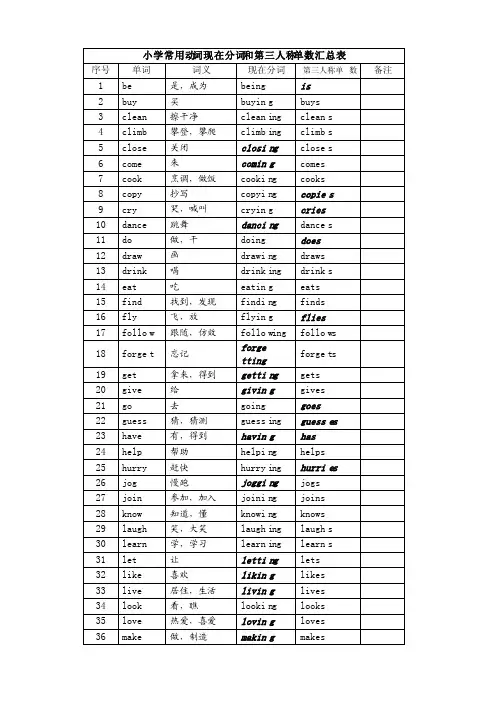
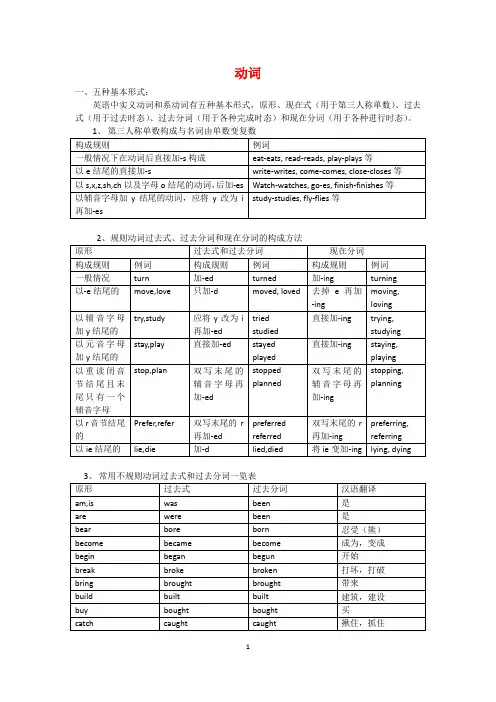
动词一、五种基本形式:英语中实义动词和系动词有五种基本形式,原形、现在式(用于第三人称单数)、过去式(用于过去时态)、过去分词(用于各种完成时态)和现在分词(用于各种进行时态)。
二、动词时态定义:时态是谓语动词所表示的动作或情况发生时间的各种形式。
四类:一般时态、进行时态、完成时态和完成进行时态。
每一类时态都对应四种时间:过去、现在、将来、过去将来。
常用8种时态:一般现在时,一般过去时,一般将来时,现在进行时,过去进行时,现在完成时,过去完成时和过去将来时。
1、一般现在时常见频度副词有:always(总是,一直),often, usually, never, sometimes等地球围绕着太阳转:The earth moves around the sun.表客观存在的真理或科学事实。
公交车来了:Here comes the bus.以here, there等开始的倒装句,表示动作正在进行。
2、一般过去时有确定的时间状语,如:yesterday, two days ago, last+年/月/星期,the other day, just now, in the old days, the day before yesterday(前天),this morning/afternoon, at the age of+过去年龄段,when引导的状语从句(过去),at+过去时间点,in+过去的年份等。
3、一般将来时常用时间副词:tomorrow, soon,(today, tonight)时间状语短语:next year/week/month, in a few days, in the future等。
构成:will/shall+动词原形,be going to+动词原形,表示打算和预测。
特殊情形:be to+动词原形,表示按计划或安排即将要发生的动作;有时也表示命令、禁止或可能性。
如:She is to practice the piano tomorrow. 她明天将练习钢琴。
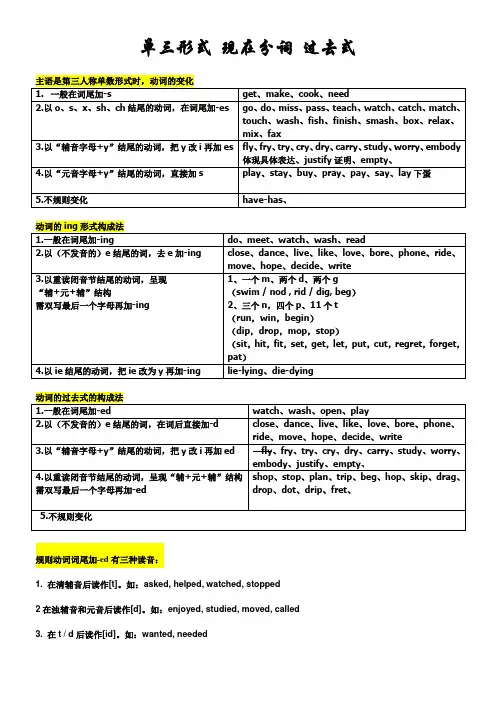
单三形式现在分词过去式规则动词词尾加-ed有三种读音:1. 在清辅音后读作[t]。
如:asked, helped, watched, stopped2在浊辅音和元音后读作[d]。
如:enjoyed, studied, moved, called3. 在t / d后读作[id]。
如:wanted, needed不规则动词的过去式见课本后的不规则动词表。
大体上归纳有以下几条记忆法:1. 以t结尾的词,过去式与原形相同。
如:put—put, let—let, cut—cut, beat—beat,cost—cost,hit—hit2. 以d结尾的词,把d变成t。
如:build—built, lend—lent, send—sent, spend—spent (read—read)3. 以n结尾的词,在词后加t。
如:mean—meant, burn—burnt, learn—learnt4. 以ow / aw结尾的词,把ow / aw变成ew。
如:blow—blew, draw—drew, know—knew, grow—grew,throw—threw5. 含有双写字母的词,将双写改为单写,在词尾加t。
如:keep—kept, sleep—slept, feel—felt, smell—smelt,sweep—swept6.只去掉一个e:feed—fed,meet—met7. 闭音节词,改i为a。
如:sit—sat, swim—swam, ring—rang, drink—drank,sing—sang,begin—began,8. 开音节词,改i为o。
如:drive—drove, ride—rode, write—wrote,9.buy—bought, bring—brought, think—thought, catch—caught, teach—taughty—laid, say—said, pay—paid母鸡“下蛋”并“摆放”好后,“说”,“付钱”11.is/am—was, are—were, have/has—had, do—did, go—went, run—ran, see—saw, fly—flew, get—got, win—won, eat—ate, come—came, make—made, tell—told, take—took, fall—fell, speak—spoke, wear—wore, stand—stood, become—became, forget—forgot, hear—heard,can—could, will—would, shall—should, find—found。
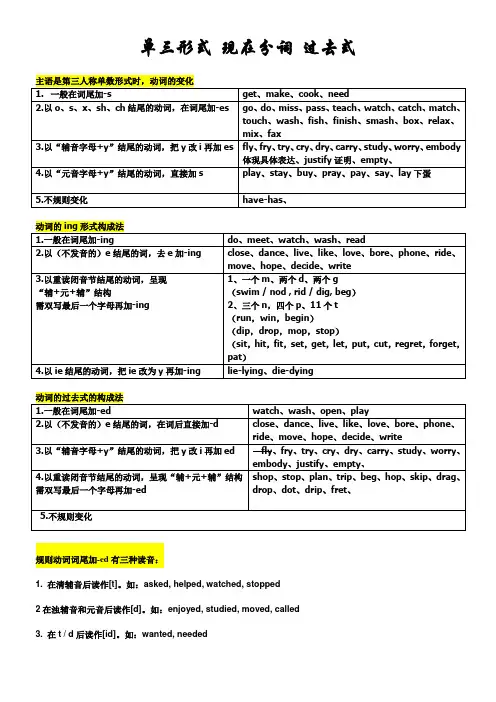
单三形式现在分词过去式规则动词词尾加-ed有三种读音:1. 在清辅音后读作[t]。
如:asked, helped, watched, stopped2在浊辅音和元音后读作[d]。
如:enjoyed, studied, moved, called3. 在t / d后读作[id]。
如:wanted, needed不规则动词的过去式见课本后的不规则动词表。
大体上归纳有以下几条记忆法:1. 以t结尾的词,过去式与原形相同。
如:put—put, let—let, cut—cut, beat—beat,cost—cost,hit—hit2. 以d结尾的词,把d变成t。
如:build—built, lend—lent, send—sent, spend—spent (read—read)3. 以n结尾的词,在词后加t。
如:mean—meant, burn—burnt, learn—learnt4. 以ow / aw结尾的词,把ow / aw变成ew。
如:blow—blew, draw—drew, know—knew, grow—grew,throw—threw5. 含有双写字母的词,将双写改为单写,在词尾加t。
如:keep—kept, sleep—slept, feel—felt, smell—smelt,sweep—swept6.只去掉一个e:feed—fed,meet—met7. 闭音节词,改i为a。
如:sit—sat, swim—swam, ring—rang, drink—drank,sing—sang,begin—began,8. 开音节词,改i为o。
如:drive—drove, ride—rode, write—wrote,9.buy—bought, bring—brought, think—thought, catch—caught, teach—taughty—laid, say—said, pay—paid母鸡“下蛋”并“摆放”好后,“说”,“付钱”11.is/am—was, are—were, have/has—had, do—did, go—went, run—ran, see—saw, fly—flew, get—got, win—won, eat—ate, come—came, make—made, tell—told, take—took, fall—fell, speak—spoke, wear—wore, stand—stood, become—became, forget—forgot, hear—heard,can—could, will—would, shall—should, find—found。
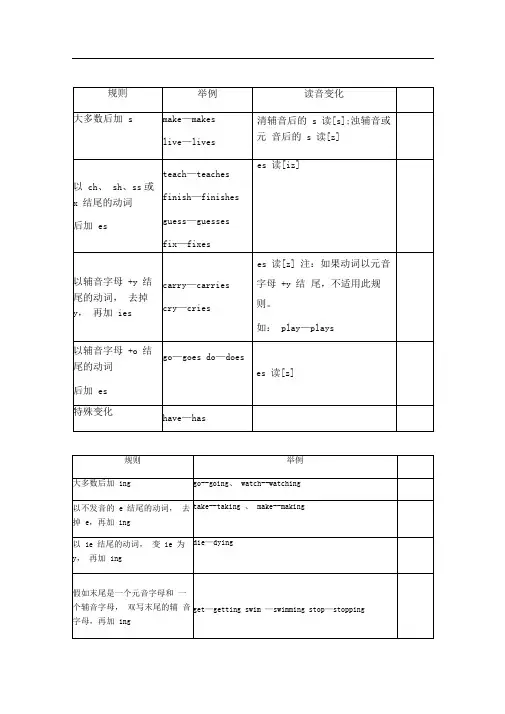
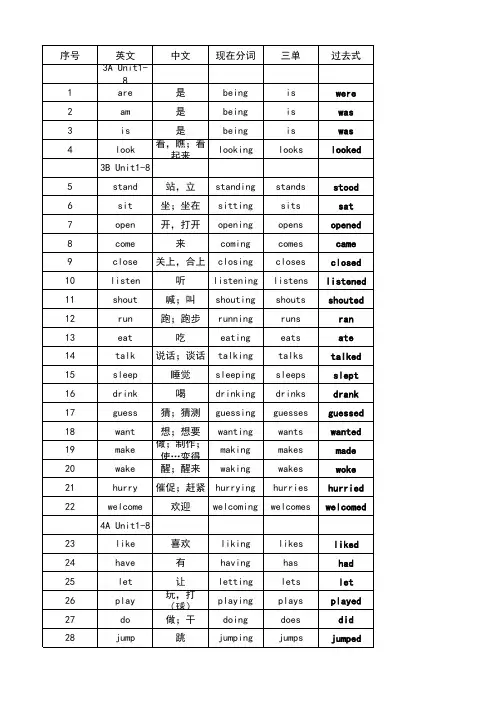
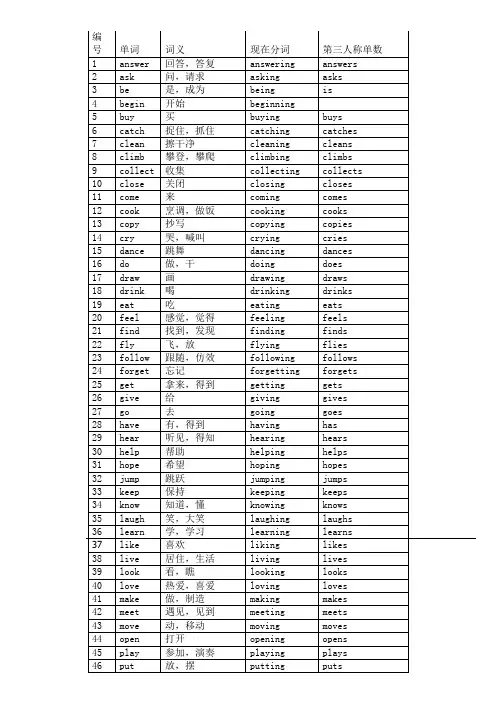
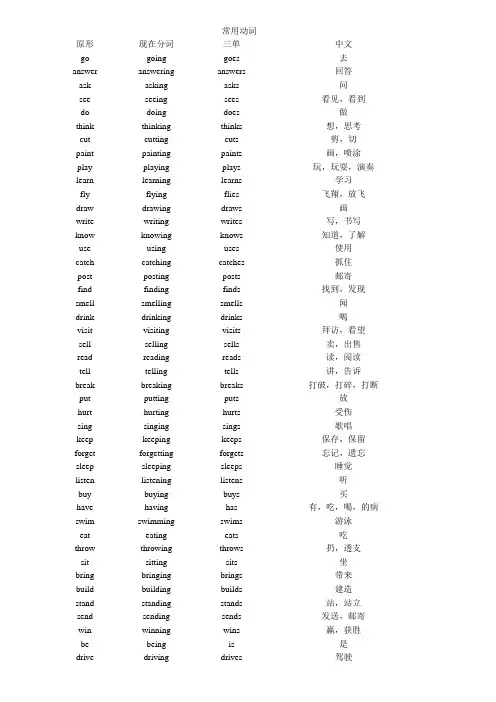
常用动词原形现在分词三单中文go going goes去answer answering answers回答ask asking asks问see seeing sees看见,看到do doing does做think thinking thinks想,思考cut cutting cuts剪,切paint painting paints画,喷涂play playing plays玩,玩耍,演奏learn learning learns学习fly flying flies飞翔,放飞draw drawing draws画write writing writes写,书写know knowing knows知道,了解use using uses使用catch catching catches抓住post posting posts邮寄find finding finds找到,发现smell smelling smells闻drink drinking drinks喝visit visiting visits拜访,看望sell selling sells卖,出售read reading reads读,阅读tell telling tells讲,告诉break breaking breaks打破,打碎,打断put putting puts放hurt hurting hurts受伤sing singing sings歌唱keep keeping keeps保存,保留forget forgetting forgets忘记,遗忘sleep sleeping sleeps睡觉listen listening listens听buy buying buys买have having has有,吃,喝,的病swim swimming swims游泳eat eating eats吃throw throwing throws扔,透支sit sitting sits坐bring bringing brings带来build building builds建造stand standing stands站,站立send sending sends发送,邮寄win winning wins赢,获胜be being is是drive driving drives驾驶常用名词单数复数中文answer answers答案apple apples苹果banana bananas香蕉bed beds床book books书,本box boxes箱子,盒子cake cakes蛋糕car cars汽车card cards卡片cat cats猫chicken chickens小鸡computer computers计算机,电脑cup cups杯子,茶杯dog dogs狗door doors门egg eggs鸡蛋factory factories工厂fish fish鱼foot feet脚fridge fridges冰箱gate gates大门ice-cream ice-creams冰激凌keyboard keyboards键盘knife knives小刀leaf leaves叶子library libraries图书馆mouse mousses老鼠,鼠标panda pandas熊猫pear pears梨person people人pig pigs猪potato potatoes番茄,西红柿question questions问题sheep sheep绵羊shelf shelves架子station stations站,所television televisions电视机thief thieves小偷,贼tomato tomatoes土豆,马铃薯tooth teeth牙,牙齿umbrella umbrellas雨伞video videos录像带wife wives妻子wolf wolves狼★一般现在时:表示经常性的事情。
1、动词第三人称单数.一般现在时的肯定句中,主语为第三人称单数的动词变化主要体现在词尾的变化上,其规律大体有三点:(1) 一般情况下由动词后加-s构成:work / works,read / reads等。
(2) 以s, x, z, sh, ch 以及字母o结构的动词,后加-es:guess / guesses, mix / mixes, go / goes, buzz / buzzes, finish / finishes, catch / catches等。
(3) 以辅音字母加y结尾的动词,应将y改为i 再加-es:fly / flies, study / studies等。
【注】①有个别的变化不规则,如have / has, be / is等。
②词尾-s和-es 读音规则是:在s, x, z, sh, ch 后的es读作[iz],其余的读作[z]。
除上述规律外,还应注意下面三点:(1). 动词 have ,遇到主语是第三人称单数时,要用 has;动词 be 的第三人称单数形式是is。
(2). 含有动词第三人称单数形式的句子变否定句时,要用 doesn't + 动词原形,如:He goes to school at six in the morning. (变否定句)→ He doesn't go to school at six in the morning. (3). 对含有动词第三人称单数形式的句子提问时,要用助动词 does,如:She goes home at five every day. (对划线部分提问)→ When / What time does she go home every day?2. 过去式和过去分词的构成方法分规则变化和不规则变化两种。
不规则变化需逐个记忆,规则变化遵循以下原则:(1) 一般情况下,在动词后加ed构成:work / worked, stay / stayed, shout / shouted等。
动词一、五种基本形式:英语中实义动词和系动词有五种基本形式;原形、现在式用于第三人称单数、过去式用于过去时态、过去分词用于各种完成时态和现在分词用于各种进行时态..1、第三人称单数构成与名词由单数变复数2、规则动词过去式、过去分词和现在分词的构成方法3、常用不规则动词过去式和过去分词一览表二、动词时态定义:时态是谓语动词所表示的动作或情况发生时间的各种形式..四类:一般时态、进行时态、完成时态和完成进行时态..每一类时态都对应四种时间:过去、现在、将来、过去将来..常用8种时态:一般现在时;一般过去时;一般将来时;现在进行时;过去进行时;现在完成时;过去完成时和过去将来时..1、一般现在时常见频度副词有:always总是;一直;often; usually; never; sometimes 等地球围绕着太阳转:The earth moves around the sun.表客观存在的真理或科学事实..公交车来了:Here comes the bus.以here; there等开始的倒装句;表示动作正在进行..2、一般过去时有确定的时间状语;如:yesterday; two days ago; last+年/月/星期;the other day; just now; in the old days; the day before yesterday前天;this morning/afternoon; at the age of+过去年龄段;when引导的状语从句过去;at+过去时间点;in+过去的年份等..3、一般将来时常用时间副词:tomorrow; soon;today; tonight时间状语短语:next year/week/month; in a few days; in the future等..构成:will/shall+动词原形;be going to+动词原形;表示打算和预测..特殊情形:be to+动词原形;表示按计划或安排即将要发生的动作;有时也表示命令、禁止或可能性..如:She is to practice the piano tomorrow. 她明天将练习钢琴..用现在进行时表示按计划或安排将要发生的事..用一般现在时表示按规定或时间表预计要发生的事..be about to+动词原形;表示即将要发生的事..4、现在进行时常与look; listen; now连用5、过去进行时the whole morning; all day yesterday; from nine to ten last evening; when; while等标志性词语;主要表示过去某一时刻或表示过去某一阶段正在发生或进行的动作..6、现在完成时:常见时间状语:always; yet; just; ever; before;these days; recently; in the past/few时间段;since+时间点;for+时间段等..构成:have/has+动词的过去分词7、过去完成时8、过去将来时Would+动词原形。
动词一、五种基本形式:英语中实义动词和系动词有五种基本形式,原形、现在式(用于第三人称单数)、过去式(用于过去时态)、过去分词(用于各种完成时态)和现在分词(用于各种进行时态)。
二、动词时态定义:时态是谓语动词所表示的动作或情况发生时间的各种形式。
四类:一般时态、进行时态、完成时态和完成进行时态。
每一类时态都对应四种时间:过去、现在、将来、过去将来。
常用8种时态:一般现在时,一般过去时,一般将来时,现在进行时,过去进行时,现在完成时,过去完成时和过去将来时。
1、一般现在时常见频度副词有:always(总是,一直),often, usually, never, sometimes等地球围绕着太阳转:The earth moves around the sun.表客观存在的真理或科学事实。
公交车来了:Here comes the bus.以here, there等开始的倒装句,表示动作正在进行。
2、一般过去时有确定的时间状语,如:yesterday, two days ago, last+年/月/星期,the other day, just now, in the old days, the day before yesterday(前天),this morning/afternoon, at the age of+过去年龄段,when引导的状语从句(过去),at+过去时间点,in+过去的年份等。
3、一般将来时常用时间副词:tomorrow, soon,(today, tonight)时间状语短语:next year/week/month, in a few days, in the future等。
构成:will/shall+动词原形,be going to+动词原形,表示打算和预测。
特殊情形:be to+动词原形,表示按计划或安排即将要发生的动作;有时也表示命令、禁止或可能性。
如:She is to practice the piano tomorrow. 她明天将练习钢琴。
常用英语动词时态表一、简单现在时 (Simple Present)动词原形或第三人称单数加 -s - I play - You play - He/She/It plays - We play - They play用法:表示经常性、习惯性的动作或事实二、现在进行时 (Present Continuous)be动词 + 现在分词 - I am playing - You are playing -He/She/It is playing - We are playing - They are playing 用法:表示正在进行或计划好的未来动作三、简单过去时 (Simple Past)动词过去式 - I played - You played - He/She/It played - We played - They played用法:表示过去某个时间点或一段时间内的动作四、过去进行时 (Past Continuous)be动词的过去形式 + 过去分词 - I was playing - You were playing - He/She/It was playing - We were playing - They were playing用法:表示过去某个时间点正在进行的动作五、将来时 (Future)will + 动词原形 - I will play - You will play - He/She/It will play - We will play - They will play用法:表示未来预期或意愿六、现在完成时 (Present Perfect)have/has + 过去分词 - I have played - You have played - He/She/It has played - We have played - They have played 用法:表示过去某时开始,一直持续到现在或刚刚完成的动作七、过去完成时 (Past Perfect)had + 过去分词 - I had played - You had played - He/She/It had played - We had played - They had played用法:表示过去某一时间点或另一动作之前已经发生的动作八、将来完成时 (Future Perfect)will have + 过去分词 - I will have played - You will have played - He/She/It will have played - We will have played - They will have played用法:表示将来某个时间点已经完成的动作九、现在完成进行时 (Present Perfect Continuous)have/has been + 现在分词 - I have been playing - You have been playing - He/She/It has been playing - We have been playing - They have been playing用法:表示从过去某时开始,一直持续到现在的动作,常强调动作的持续性和重复性以上是常用英语动词时态表的概况,通过这份表格,我们可以更好地了解和掌握英语动词的不同时态,从而有助于正确表达和理解句子的时间关系。
英语语法大全下载1、所有格:He is Fred's best friend.(-'s)以S结尾直接(-')2、动词现在时的第三人称单数:Alfredo works.(-s)1、一般情况下,动词后直接加s,如:works,gets,reads等。
2、以s,x,ch,sh或o结尾的动词,在后面加es,如:goes,teaches,washes等。
3、以辅音字母加y结尾的动词,把y变为i,再加es,如:study--studies,try--tries,carry--carries等。
4、动词have遇在主语是第三人称单数时,have改为has,如:He has an interesting book .5、动词be遇有主语是第一人称单数时,be改为am,遇有主语是第二人称时,be 改为are,遇有主语是第三人称单数时,be改为is3、动词过去式:Fred worked.(-ed),但亦有不规则变化。
4、现在分词/进行时态:Fred is working.(-ing)([注]如果动词的末音节为辅音结尾的闭音节,则须双写末辅音,如running,以不发音的E结尾把E去掉+ing)5、过去分词:The car was stolen.(-en);Fred has talked to the police.(-ed)规则动词的过去式和过去分词变化如下:1、一般情况下,动词词尾加-ed ,如:work ---worked play---played wanted----wanted act----acted2、以不发音的-e 结尾动词,动词词尾加-d,如:live---lived move----moved taste---tasted hope---hoped3、以辅音字母+ y结尾的动词,把-y变为-i 再加-ed,如:study---studied copy---copied cry---cried carry---carried4、以一个辅音字母结尾的重读闭音节动词,双写词尾辅音字母,再加-ed,如:stop ---stopped5、不规则动词的过去式变化规律性不强,须多加记忆。